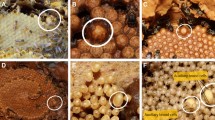Abstract
The development of animals depends on both genetic and environmental effects to a varying extent. Their relative influences can be evaluated in the social insects by raising the intracolonial diversity to an extreme in nests consisting of workers from more than one species. In this study, we studied the effects of mixed honeybee colonies of Apis mellifera and Apis cerana on the rearing of grafted queen larvae of A. cerana. A. mellifera sealed worker brood was introduced into A. cerana colonies and on emergence, the adults were accepted. Then, A. cerana larvae were grafted for queen rearing into two of these mixed-species colonies. Similarly, A. cerana larvae and A. mellifera larvae were also grafted conspecifically as controls. The success rate of A. cerana queen rearing in the test colonies was 64.5%, surpassing all previous attempts at interspecific queen rearing. After emergence, all virgin queens obtained from the three groups (N=90) were measured morphometrically. The A. cerana queens from the mixed-species colonies differed significantly in size and pigmentation from the A. cerana control queens and closely approximated the A. mellifera queens. It is inferred that these changes in the A. cerana queens reared in the mixed-species colonies can be attributed to feeding by heterospecific nurse bees and/or chemical differences in royal jelly. Our data show a strong impact of environment on the development of queens. The results further suggest that in honeybees the cues for brood recognition can be learned by heterospecific workers after eclosion, thereby providing a novel analogy to slave making in ants.


Similar content being viewed by others
References
Atwal AS, Sharma OP (1967) The introduction of Apis mellifera queens into Apis indica colonies and the associated behavior of the two species. XXI International Beekeeping Congress, Preliminary Science Meeting, Summary Paper 70–77.
Adlakha RL, Sharma OP (1971) Interspecific introduction of queens (Apis mellifera queens into A. indica nuclei). Proceedings of the 23rd International Apiculture Congress, Moscow. Apimondia 402.
Ayasse M, Paxton RJ (2002) Brood protection in social insects. In: Hilker M, Meiners T (eds) Chemoecology of insect eggs and egg deposition. Blackwell, Oxford, pp 117–148
Breed MD, Perry S, Bjostad LB (2004) Testing the blank slate hypothesis: why honey bee colonies accept young bees. Insectes Soc 51:12–16
Dhaliwal GS, Atwal AS (1970) Interspecific relations between Apis cerana indica and Apis mellifera. J Apic Res 9:53–59
Hölldobler B, Wilson EO (1990) The Ants. Harvard University Press, Cambridge
Inoue A (1962) Preliminary report on the rearing of Japanese honeybee queens in colonies of the European honeybee. Indian Bee J 24:73–74
Johnson RA, Wichern DW (1998) Applied multivariate statistical analysis, Fourth Edition, Prentice-Hall, Upper Saddle River, New Jersey
Kuwabara M (1947) Über die Regulation im weisellosen Volke der Honigbiene, besonders die Bestimmung des neuen Weisels. J Fac Sci Hokkaido Univ Ser 6, 9:359–381
Laloi D, Gallois M, Roger B Pham-Delegue MH (2001) Changes with age in olfactory conditioning performance of worker honey bees (Apis mellifera). Apidologie 32:231–242
Matsuka M, Tsurata T, Sasaki M (1995) Temperature as a causative factor of the seasonal colour dimorphism in Apis cerana japonica. In: Kevan PG (ed) The Asiatic hive bee: apiculture, biology, and role in sustainable development in tropical and subtropical Asia
Meixner M (1994) Analyse polymorpher Subspezies von A. mellifera L.: Morphometrische und molekulare Untersuchungen an den europäischen Rassen A. mellifera carnica und ligustica und den afrikanischen Rassen A. mellifera monticola und scutellata. Ph.D. thesis, Fachbereich Biologie der J. W. Goethe-Universität, Frankfurt am Main, Germany
Oku N, Ono M (1990) Preliminary attempts to rear larvae of the Japanese honeybee, Apis cerana japonica, in an Apis mellifera colony and in the laboratory using A. mellifera royal jelly. Honeybee Sci 3:121–124 (in Japanese)
Oschmann H (1965) Can Apis mellifica bees rear brood of A. cerana? Die Biene Giessen 101:150–151 (in German)
Pham-Delegue MH, Trouiller J, Caillaud CM, Roger B, Masson C (1993) Effect of queen pheromone on worker bees of different ages: behavioural and electrophysiological responses. Apidologie 24:267–281
Potichot S, Wongsiri S, Dietz A (1993) Attempts in queen rearing of Apis cerana larvae in Apis mellifera colonies and Apis mellifera larvae in Apis cerana colonies. In Connor LJ, Rinderer TE, Sylvester HA, Wongsiri S (eds) Asian apiculture, Wicwas, Cheshire, Connecticut, pp 128–133
Ribbands CR (1953) The behaviour and social life of honeybees. Bee Research Association, London
Ruttner F (1988) Biogeography and taxonomy of honeybees. Springer, Berlin Heidelberg New York
Ruttner F, Tassencourt L, Louveaux J (1978) Biometrical-statistical analysis of the geographic variability of Apis mellifera. Apidologie 9:363–381
Su S, Albert S, Chen S, Zhong B (2005) Molecular cloning and analysis of four cDNAs from the heads of Apis cerana cerana nurse honeybees coding for major royal jelly proteins. Apidologie 36:389–401
Takenaka T, Takenaka Y (1996) Royal jelly from Apis cerana and Apis mellifera. Biosci Biotechnol Biochem 60:518–520
Tsurata T, Matsuka M, Sasaki M (1989) Temperature as a causative factor in the seasonal colour dimorphism of Apis cerana japonica workers. Apidologie 20:149–155
Whiffler LA, Drusedau MUH, Crewe RN, Hepburn HR (1988) Defensive behaviour and the division of labour in the African honeybee (Apis mellifera scutellata). J Comp Physiol A 163:401–411
Yang GH (2001) Chinese honeybee (Apis cerana). Editorial House of China Agricultural Science and Technology, Beijing (in Chinese)
Acknowledgements
We are grateful to two anonymous referees for their constructive comments. Financial support was granted by the Xishuangbanna Tropical Botanical Garden, Chinese Academy of Science and the Yunnan agricultural University of China to TK and by the DFG to PN.
Author information
Authors and Affiliations
Corresponding author
Rights and permissions
About this article
Cite this article
Tan, K., Hepburn, H.R., He, S. et al. Gigantism in honeybees: Apis cerana queens reared in mixed-species colonies. Naturwissenschaften 93, 315–320 (2006). https://doi.org/10.1007/s00114-006-0113-2
Received:
Accepted:
Published:
Issue Date:
DOI: https://doi.org/10.1007/s00114-006-0113-2




